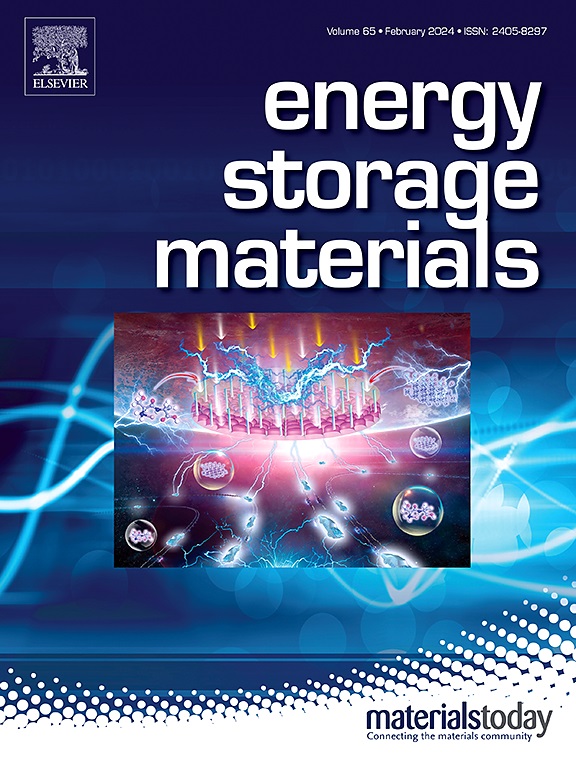用于可穿戴生物医学设备集成储能和自诊断健康监测的Zn-PAA-C水凝胶
IF 20.2
1区 材料科学
Q1 CHEMISTRY, PHYSICAL
引用次数: 0
摘要
可穿戴生物医学设备需要同时集成能量存储和传感,在极端条件下工作,并实现电池自诊断的材料。为了解决这个问题,我们开发了一种新型的负载ZnCl 2的聚丙烯酸基复合水凝胶(Zn-PAA-C),既可以作为柔性锌离子电池电解质,又可以作为高性能应变传感器。工程与聚(丙烯酸)n-羟基琥珀酰亚胺酯(PAA-NHS),明胶和乙二醇,锌- paa -C表现出优异的离子电导率,机械弹性和抗冻性(低至-80°C)。作为应变传感器,它实现了宽的传感范围(0-180%应变),可靠的工作(1-7 Hz)和快速的响应(57 ms)。作为一种电池电解质,它独特地融合了自诊断功能,能够实时监测电池膨胀和枝晶形成,从而提高安全性和寿命,并支持超过12,000次充放电循环的稳定运行。因此,Zn-PAA-C超越了传统凝胶电解质的限制,为可穿戴生物医学设备中的多功能材料建立了新的标准,能够在极端条件下进行稳健、连续的健康监测。本文章由计算机程序翻译,如有差异,请以英文原文为准。
Zn-PAA-C hydrogel for integrated energy storage and self-diagnostic health monitoring in wearable biomedical devices
Wearable biomedical devices require materials that simultaneously integrate energy storage and sensing, function under extreme conditions, and enable battery self-diagnosis. To address this, we developed a novel ZnCl₂-loaded poly(acrylic acid)-based composite hydrogel (Zn-PAA-C) serving as both a flexible Zn-ion battery electrolyte and a high-performance strain sensor. Engineered with poly(acrylic acid) N-hydroxysuccinimide ester (PAA-NHS), gelatin, and ethylene glycol, Zn-PAA-C exhibits exceptional ionic conductivity, mechanical resilience, and freeze-resistance (down to -80 °C). As a strain sensor, it achieves a broad sensing range (0–180 % strain), reliable operation (1–7 Hz), and rapid response (57 ms). As a battery electrolyte, it uniquely incorporates self-diagnostic capability, enabling real-time monitoring of battery expansion and dendrite formation for enhanced safety and longevity, and supports stable operation over 12,000 charge-discharge cycles. Zn-PAA-C thus transcends traditional gel electrolyte limitations, establishing a new standard for multifunctional materials in wearable biomedical devices capable of robust, continuous health monitoring under extreme conditions.
求助全文
通过发布文献求助,成功后即可免费获取论文全文。
去求助
来源期刊

Energy Storage Materials
Materials Science-General Materials Science
CiteScore
33.00
自引率
5.90%
发文量
652
审稿时长
27 days
期刊介绍:
Energy Storage Materials is a global interdisciplinary journal dedicated to sharing scientific and technological advancements in materials and devices for advanced energy storage and related energy conversion, such as in metal-O2 batteries. The journal features comprehensive research articles, including full papers and short communications, as well as authoritative feature articles and reviews by leading experts in the field.
Energy Storage Materials covers a wide range of topics, including the synthesis, fabrication, structure, properties, performance, and technological applications of energy storage materials. Additionally, the journal explores strategies, policies, and developments in the field of energy storage materials and devices for sustainable energy.
Published papers are selected based on their scientific and technological significance, their ability to provide valuable new knowledge, and their relevance to the international research community.
 求助内容:
求助内容: 应助结果提醒方式:
应助结果提醒方式:


